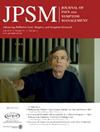Collective Bargaining: Tour of East and South Asian Cultural Medical Decision Making
IF 3.2
2区 医学
Q2 CLINICAL NEUROLOGY
引用次数: 0
Outcomes
1. Participants will self-report the ability to identify considerations that shape medical decision-making preferences for East and South Asian families (e.g., roles of patients and families, attitudes towards clinicians, religious/spiritual influences, and community organizations).
2. Participants will apply a framework based on cultural humility while navigating shared decision making with their ESA patients and families.
Key Message
As Asian American communities grow in the U.S., clinicians will increasingly care for diverse families affected by serious illness, who may not consider patient autonomy as the consummate value. This interdisciplinary panel will use clinical vignettes to model a systematic approach for identifying factors that influence decision-making preferences when caring for East and South Asian families facing serious illness.
Abstract
The National Institute of Health's Minority Health and Health Disparities Research Framework highlights a key social determinant of health being medical decision-making (MDM) (1). This can be challenging when palliative care clinicians care for patients whose MDM at end-of-life is culturally discordant (2-5). One such patient population is the diverse and fast growing Asian American (AA) population (6). As clinicians support AA families, they may feel unprepared to reconcile families’ cultural preferences for collective MDM with the American healthcare system's orientation towards autonomous MDM (3).
Objectives
Using a case-based approach, an interdisciplinary panel, consisting of clinicians and caregivers, will use the ABCDE Cultural Assessment Model (7) to equip clinicians in uncovering factors that impact MDM in East and South Asians grappling with serious illness. Factors may include roles of patients and families, attitudes towards clinicians, religious/spiritual considerations, and community resources. This session will help clinicians compare and contrast MDM nuances amongst East and South Asian cultures, ultimately improving clinician-patient interaction skills, enhancing cultural humility, and reducing healthcare disparities.
Conclusion
Palliative care clinicians will apply an evidence-based model of cultural humility to real-world scenarios of collective MDM, to improve care for Asian families affected by serious illness and reduce healthcare disparities.
References
1. Alvidrez J, Castille D, Laude-Sharp M, Rosario A, Tabor D. The National Institute on Minority Health and Health Disparities Research Framework. Am J Public Health. 2019 Jan;109(S1):S16-S20. 2. Madni A. Culturally Responsive Care for Patients With a Serious Illness. Journal of Palliative Medicine 2024 27:5, 699-701 3. Jia Z, Leiter RE, Sanders JJ, et al. Asian American Medicare Beneficiaries Disproportionately Receive Invasive Mechanical Ventilation When Hospitalized at the End-of-Life. J Gen Intern Med. 2022;37(4):737-744. 4. Patel, RV, Bowden, JM, Boselli, D, et al. The influence of religion/spirituality (R/S) on end of life (EOL) outcomes among patients of Dharmic religions with cancer: A mixed methods study. JCO Oncology Practice 2023 19:11_suppl, 230-230 5. Pan CX, Luo EJ, Wang E, et al. Top Ten Tips Palliative Care Clinicians Should Know About Caring for Chinese American Patients. J Palliat Med. 2023;26(3):423-430. doi:10.1089/jpm.2022.0470 6. Pew Research Center. (April 9, 2021). Asian Americans are the fastest-growing racial or ethnic group in the U.S. https://www.pewresearch.org/short-reads/2021/04/09/asian-americans-are-the-fastest-growing-racial-or-ethnic-group-in-the-u-s/ 7. Cain CL, Surbone A, Elk R, Kagawa-Singer M. Culture and Palliative Care: Preferences, Communication, Meaning, and Mutual Decision Making. J Pain Symptom Manage. 2018 May;55(5):1408-1419.
集体谈判:东亚和南亚文化医疗决策之旅
Outcomes1。参与者将自我报告识别影响东亚和南亚家庭医疗决策偏好的因素的能力(例如,患者和家庭的角色、对临床医生的态度、宗教/精神影响和社区组织)。参与者将在与ESA患者和家属共同决策时应用基于文化谦逊的框架。随着亚裔美国人社区在美国的发展,临床医生将越来越多地照顾受严重疾病影响的不同家庭,他们可能不认为患者自主是完美的价值。这个跨学科小组将使用临床小片段来模拟一种系统的方法,以确定在照顾面临严重疾病的东亚和南亚家庭时影响决策偏好的因素。摘要美国国立卫生研究院的少数民族健康和健康差异研究框架强调了医疗决策(MDM)是健康的一个关键社会决定因素(1)。当姑息治疗临床医生护理临终MDM文化不一致的患者时,这可能是具有挑战性的(2-5)。其中一个这样的患者群体是多样化和快速增长的亚裔美国人(AA)人口(6)。当临床医生支持AA家庭时,他们可能会觉得没有准备好调和家庭对集体MDM的文化偏好与美国医疗保健系统对自主MDM的倾向(3)。将使用ABCDE文化评估模型(7)来帮助临床医生发现影响东亚和南亚人与严重疾病作斗争的MDM的因素。因素可能包括患者和家属的角色、对临床医生的态度、宗教/精神方面的考虑以及社区资源。本课程将帮助临床医生比较和对比东亚和南亚文化中MDM的细微差别,最终提高医患互动技巧,增强文化谦逊,减少医疗保健差异。结论姑息治疗临床医生将基于证据的文化谦逊模式应用于集体MDM的现实场景,以改善对受严重疾病影响的亚洲家庭的护理,并减少医疗保健差异。Alvidrez J, Castille D, Laude-Sharp M, Rosario A, Tabor D.国家少数民族健康和健康差异研究框架研究所。中华卫生杂志,2019,31 (S1): 516 - 520。2. Madni a .重病患者的文化响应性护理。[j] .中国生物医学工程学报,2011,27(5):699-701。贾志,Leiter RE, Sanders JJ,等。亚裔美国医疗保险受益人在临终住院时不成比例地接受有创机械通气。中华普通实习医学杂志,2022;37(4):737-744。4. Patel, RV, Bowden, JM, Boselli, D,等。宗教/灵性(R/S)对佛教癌症患者生命终结(EOL)结果的影响:一项混合方法研究。JCO肿瘤学实践2023 19:11 _supply, 230-230潘彩霞,罗恩杰,王娥,等。姑息治疗医师照顾美籍华人患者应了解的十大建议。中华检验医学杂志,2009;26(3):423-430。doi: 10.1089 / jpm.2022.0470 6。皮尤研究中心。(2021年4月9日)。亚裔美国人是美国增长最快的种族或族裔群体https://www.pewresearch.org/short-reads/2021/04/09/asian-americans-are-the-fastest-growing-racial-or-ethnic-group-in-the-u-s/ 7。王晓明,王晓明,王晓明。文化与姑息治疗的关系研究进展。[J] .中华疼痛杂志,2018;55(5):1408-1419。
本文章由计算机程序翻译,如有差异,请以英文原文为准。
求助全文
约1分钟内获得全文
求助全文
来源期刊
CiteScore
8.90
自引率
6.40%
发文量
821
审稿时长
26 days
期刊介绍:
The Journal of Pain and Symptom Management is an internationally respected, peer-reviewed journal and serves an interdisciplinary audience of professionals by providing a forum for the publication of the latest clinical research and best practices related to the relief of illness burden among patients afflicted with serious or life-threatening illness.

 求助内容:
求助内容: 应助结果提醒方式:
应助结果提醒方式:


